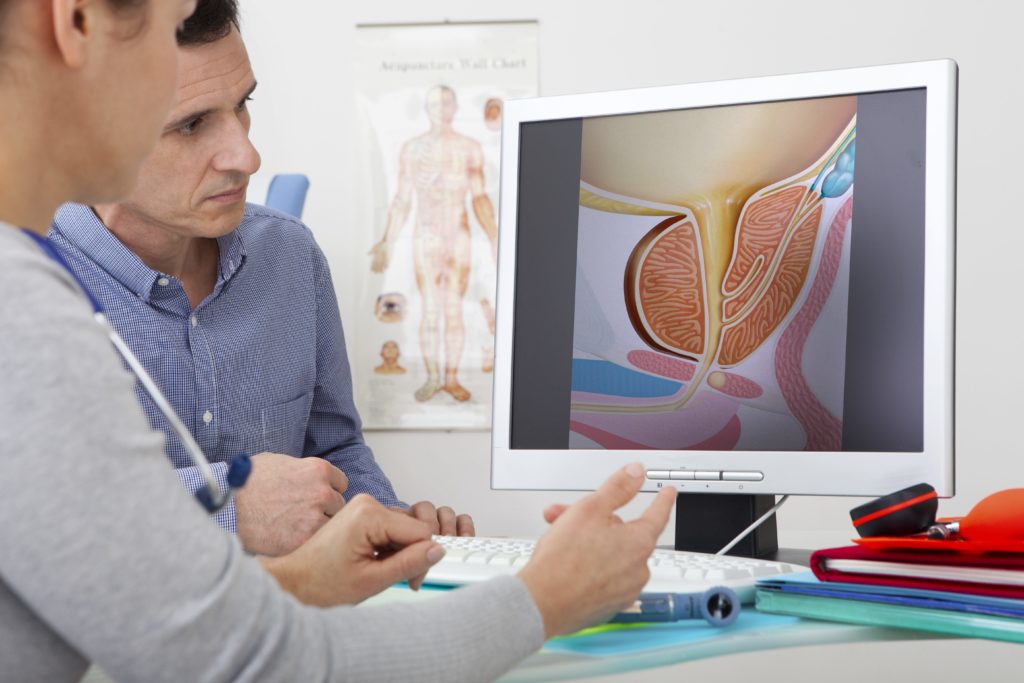1 in 9 men will be diagnosed with prostate cancer during their lifetime. A prostate biopsy is commonly used to diagnose prostate cancer. But a non-invasive, non-surgical alternative exists: prostate MRI. Learn about the advantages of prostate MRI, which may save you from an unnecessary biopsy. And talk to your care provider about having your prostate MRI performed at UVA Medical Center.
The Facts: The Prostate and Prostate Cancer

The prostate is an organ that is a part of the male reproductive system. It is located in the pelvis in front of the rectum and between the bladder and penis. The prostate may be small, but it has an important job: producing semen, the fluid that carries sperm from the testicles out of the body.
Though some prostate cancer can grow and spread quickly, it usually spreads slowly. Autopsies of men who die of other causes sometimes reveal prostate cancer that went unnoticed and didn’t affect them during their lives.
After skin cancer, prostate cancer is the most common form of cancer in American men. Though prostate cancer affects men widely, most men do not die from it: the American Cancer Society estimates that 1 in 9 men will be diagnosed with prostate cancer, but just 1 in 41 men will die from prostate cancer.
Early Screening Tools
Most screening for prostate cancer begins with a prostrate-specific antigen (PSA) test. PSA is an enzyme found in the prostate, and a high level of PSA can be a flag for prostate cancer or other prostate issues. Your doctor may also perform a digital rectal exam to feel for any bumps or hard areas on your prostate that might indicate cancer.
Neither the PSA test nor the digital rectal exam are 100% accurate. If the results of either of those tests suggest cancer, further tests will be needed to confirm the diagnosis. The test most often used is a prostate biopsy.
Prostate Biopsy – The Standard Screening Option, but Not Without Flaws
During a prostate biopsy, a thin needle is inserted through the wall of your rectum and into the prostate to collect a sample of tissue. This may be repeated up to 12 times to take 12 separate samples. Most doctors will use a local anesthetic to numb the area, and blood may persist in the urine or semen for a few weeks after the biopsy. If the areas the doctor collected did not have cancer, a follow up biopsy might be performed.
A prostate biopsy can occasionally cause bleeding, pain and infection. And it can lead to the diagnosis of clinically insignificant cancers that would never have been detected or caused any problems for the patients.
Prostate MRI – A Non-Invasive Alternative

MRI stands for magnetic resonance imaging. An MRI machine is essentially a large, powerful magnet. The machine uses magnetic and radio waves to produce detailed images of soft tissues and structures in the body, like the prostate.
During a prostate MRI, the patient is positioned on an examination table that is then slid into the MRI machine. The scan takes about 30-45 minutes to complete.
Because an MRI uses magnetic waves to image the inside of your body, a prostate MRI is totally painless and non-invasive. Not only is a prostate MRI as accurate as a biopsy at detecting prostate cancers, but it can also tell how advanced the cancer is and if it has spread to other parts of the body. A prostate MRI can also detect other prostate conditions, like infections or benign prostatic hyperplasia (BPH). And it is better than prostate biopsies at differentiating between clinically significant and insignificant cancers.
At UVA, we do not use an endorectal coil (a thin wire covered with a latex balloon which is inserted a short distance into the rectum) when performing a prostate MRI, so the procedure is much like a normal MRI. This makes the procedure much simpler and more comfortable.
Click here to learn more about preparing for an MRI of your prostate. For more information about MRI procedures, take a look at our articles on MRI vs CT and Reducing MRI Claustrophobia.
Have Your Prostate MRI at UVA Medical Center
If you are at risk for prostate cancer, talk with your care provider about having your prostate MRI done at UVA Medical Center. Contact the UVA Medical Center at (434) 982-6600 to learn more.
Reviewed by Arun Krishnaraj, MD
Infographic Text – 4 Reasons to Choose a Prostate MRI
- May help you avoid a painful biopsy
- Non-invasive and pain-free
- Can tell how advanced cancer is and whether it has spread
- Can detect other prostate conditions



